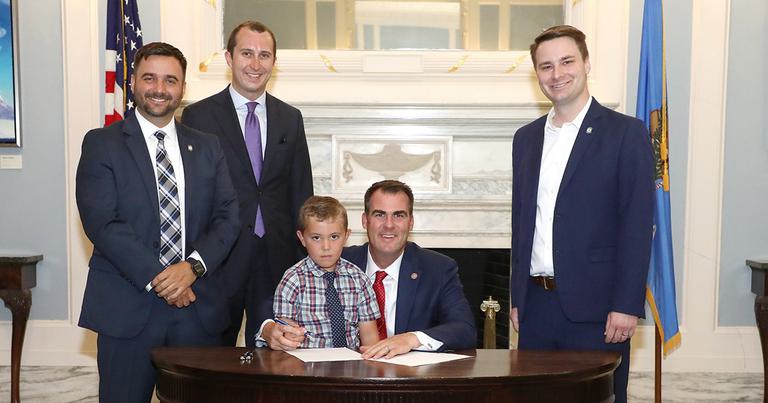
Good Government
Ray Carter | August 6, 2019
Government transparency bill signed in ceremony
Ray Carter
Senate Bill 271, by state Sen. Nathan Dahm and state Rep. Kyle Hilbert, requires state agencies to post annual reports online that list “all federal funds” under the agency’s control and identify, in descending order, the funding source the agency relies on “to the greatest extent.”
Gov. Kevin Stitt officially signed that measure into law on April 29, but he and supporters gathered on Tuesday to repeat the exercise in a brief ceremonial bill signing.
Supporters say the bill will boost public awareness of true spending at state agencies, not just the slice of spending directed by lawmakers through appropriations.
“Having this information from the federal level will allow us to see whenever the state agencies are saying they need more state money, more state taxpayer funds, do they really need that or not?” said Dahm, R-Broken Arrow.
At the Capitol, he noted lawmakers often focus on appropriated dollars and ignore “non-appropriated” funds. But, regardless of the funding stream, Dahm stressed that all government money comes from citizens.
“Sometimes they forget that, that it’s actually money that we’re taking out of the taxpayers’ pockets,” Dahm said.
During the recent state recession some officials who supported tax increases routinely claimed certain agencies’ funding had been cut by as much as 40 percent. But those claims were typically based only on changes in state appropriations. In reality, total overall funding at many agencies had offset much of the reduction in appropriations and some agencies even increased overall spending as they were being “cut.”
For example, the appropriation for the Oklahoma Space Industry Development Authority was cut from $394,589 in the 2013 budget year to $305,189 in 2017, a reduction of more than 22 percent. But during that same time, total spending at the Oklahoma Space Industry Development Authority surged from $2.3 million to $2.6 million, thanks to other funding sources, and the agency’s spending hit $3.1 million by 2018.
The same pattern can be seen in total state government spending, which increased from $15.02 billion in fiscal year 2008 to $17.53 billion in fiscal year 2017, based on one set of reported figures.
Dahm believes the smoke-and-mirrors budget games played in the past will be more difficult if financial information is readily available to the public.
“Those 40-percent numbers and some of those things, a lot of it was they were just looking at one funding source that was cut, not their overall funding sources,” Dahm said. “So when you take into consideration they’re getting federal funds, they’re getting state funds, local funds, fines, fees, whatever the case may be, you get a better overall picture of what finances they do have and how that money is actually being spent.”
Efforts to increase financial transparency in state government have been ongoing for several years. Legislation similar to Senate Bill 271 also passed the Legislature in 2015, but was vetoed by former Gov. Mary Fallin.

Ray Carter
Director, Center for Independent Journalism
Ray Carter is the director of OCPA’s Center for Independent Journalism. He has two decades of experience in journalism and communications. He previously served as senior Capitol reporter for The Journal Record, media director for the Oklahoma House of Representatives, and chief editorial writer at The Oklahoman. As a reporter for The Journal Record, Carter received 12 Carl Rogan Awards in four years—including awards for investigative reporting, general news reporting, feature writing, spot news reporting, business reporting, and sports reporting. While at The Oklahoman, he was the recipient of several awards, including first place in the editorial writing category of the Associated Press/Oklahoma News Executives Carl Rogan Memorial News Excellence Competition for an editorial on the history of racism in the Oklahoma legislature.